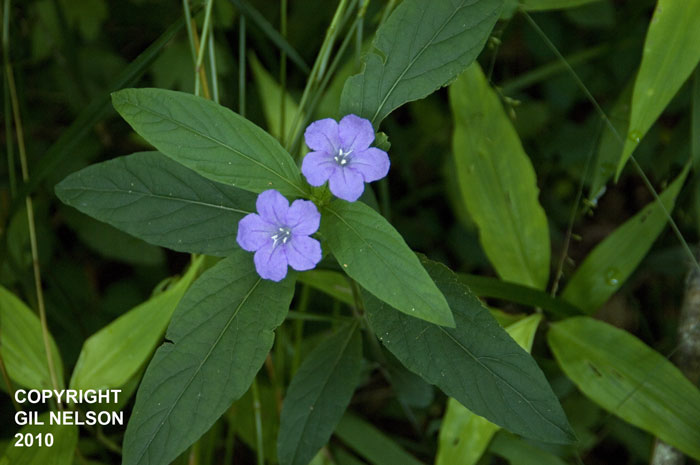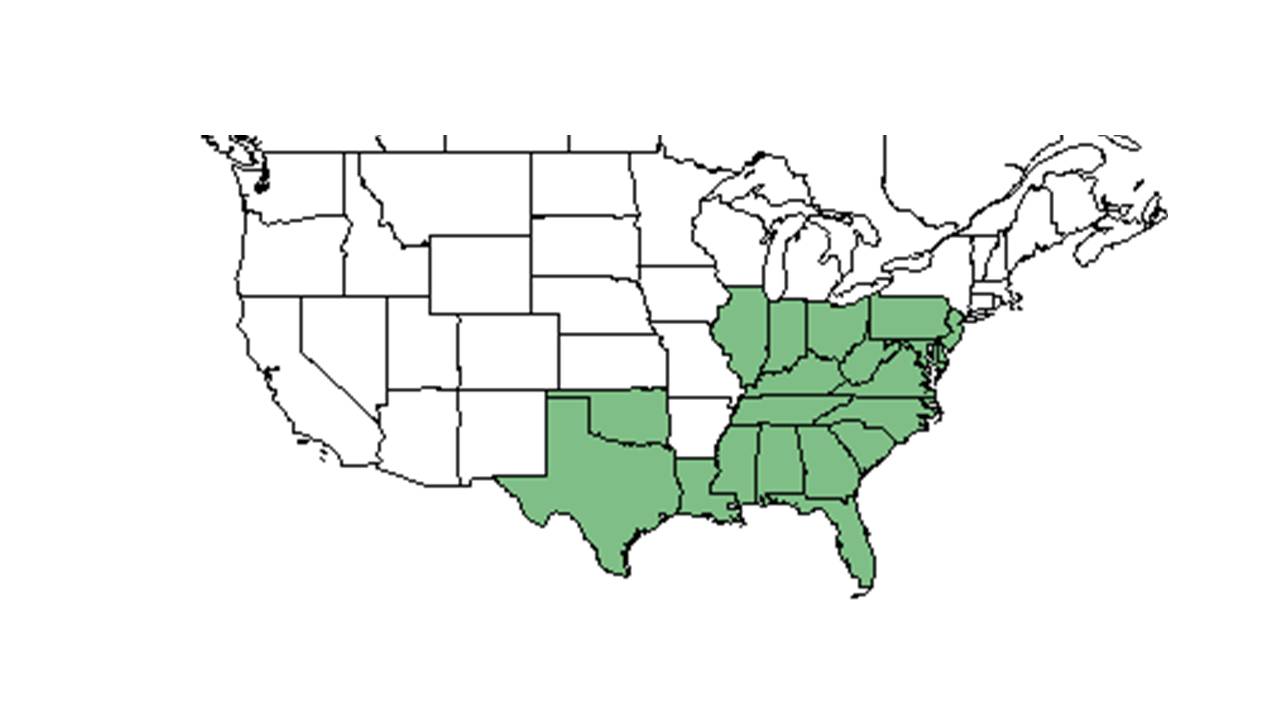Difference between revisions of "Ruellia caroliniensis"
Lsandstrum (talk | contribs) (→Ecology) |
Lsandstrum (talk | contribs) |
||
| Line 35: | Line 35: | ||
==Ecology== | ==Ecology== | ||
===Habitat=== <!--Natural communities, human disturbed habitats, topography, hydrology, soils, light, fire regime requirements for removal of competition, etc.--> | ===Habitat=== <!--Natural communities, human disturbed habitats, topography, hydrology, soils, light, fire regime requirements for removal of competition, etc.--> | ||
| − | In the Coastal Plain in Florida and Georgia, ''R. caroliniensis'' can be found in the edges of wooded floodplains, mesic hardwood floodplains, drying sand of open woodlands, flatwoods, sandy alluvial banks, shallow marshes, and on bluffs along the Apalachicola River. <ref name="FSU Herbarium">Florida State University Robert K. Godfrey Herbarium database. URL: [http://herbarium.bio.fsu.edu http://herbarium.bio.fsu.edu]. Last accessed: July 2015. Collectors: Lisa Keppner, Ed Keppner, Loran C. Anderson, R.K. Godfrey, Cecil R Slaughter, Jimmy Meeks, R. Komarek, R. A. Norris. States and Counties: Florida: Bay, Dixie, Franklin, Gadsden, Leon, Liberty, Marion, Okaloosa, Washington. Georgia: Grady. Compiled by Tall Timbers Research Station and Land Conservancy.</ref> Soils include sandy loams, sand, and loamy sand. <ref name="FSU Herbarium"/> Associated species include oak, hickory, dogwood, pine, juniper and magnolia. <ref name="FSU Herbarium"/> When exposed to soil disturbance by military training in West Georgia, ''R. caroliniensis'' responds negatively by way of absence.<ref>Dale, V.H., S.C. Beyeler, and B. Jackson. (2002). Understory vegetation indicators of anthropogenic disturbance in longleaf pine forests at Fort Benning, Georgia, USA. Ecological Indicators 1(3):155-170.</ref> ''R. caroliniensis'' responds negatively to soil disturbance by agriculture in Southwest Georgia.<ref>Hedman, C.W., S.L. Grace, and S.E. King. (2000). Vegetation composition and structure of southern coastal plain pine forests: an ecological comparison. Forest Ecology and Management 134:233-247.</ref> | + | In the Coastal Plain in Florida and Georgia, ''R. caroliniensis'' can be found in the edges of wooded floodplains, mesic hardwood floodplains, drying sand of open woodlands, flatwoods, sandy alluvial banks, shallow marshes, and on bluffs along the Apalachicola River. <ref name="FSU Herbarium">Florida State University Robert K. Godfrey Herbarium database. URL: [http://herbarium.bio.fsu.edu http://herbarium.bio.fsu.edu]. Last accessed: July 2015. Collectors: Lisa Keppner, Ed Keppner, Loran C. Anderson, R.K. Godfrey, Cecil R Slaughter, Jimmy Meeks, R. Komarek, R. A. Norris. States and Counties: Florida: Bay, Dixie, Franklin, Gadsden, Leon, Liberty, Marion, Okaloosa, Washington. Georgia: Grady. Compiled by Tall Timbers Research Station and Land Conservancy.</ref> Soils include sandy loams, sand, and loamy sand. <ref name="FSU Herbarium"/> Associated species include oak, hickory, dogwood, pine, juniper and magnolia. <ref name="FSU Herbarium"/> When exposed to soil disturbance by military training in West Georgia, ''R. caroliniensis'' responds negatively by way of absence.<ref>Dale, V.H., S.C. Beyeler, and B. Jackson. (2002). Understory vegetation indicators of anthropogenic disturbance in longleaf pine forests at Fort Benning, Georgia, USA. Ecological Indicators 1(3):155-170.</ref> ''R. caroliniensis'' responds negatively to soil disturbance by agriculture in Southwest Georgia.<ref>Hedman, C.W., S.L. Grace, and S.E. King. (2000). Vegetation composition and structure of southern coastal plain pine forests: an ecological comparison. Forest Ecology and Management 134:233-247.</ref><ref>Kirkman, L.K., K.L. Coffey, R.J. Mitchell, and E.B. Moser. Ground Cover Recovery Patterns and Life-History Traits: Implications for Restoration Obstacles and Opportunities in a Species-Rich Savanna. (2004). Journal of Ecology 92(3):409-421.</ref> |
===Phenology=== <!--Timing off flowering, fruiting, seed dispersal, and environmental triggers. Cite PanFlora website if appropriate: http://www.gilnelson.com/PanFlora/ --> | ===Phenology=== <!--Timing off flowering, fruiting, seed dispersal, and environmental triggers. Cite PanFlora website if appropriate: http://www.gilnelson.com/PanFlora/ --> | ||
Revision as of 19:35, 15 July 2019
| Ruellia caroliniensis | |
|---|---|

| |
| Photo taken by Gil Nelson | |
| Scientific classification | |
| Kingdom: | Plantae |
| Division: | Magnoliophyta – Flowering plants |
| Class: | Magnoliopsida – Dicotyledons |
| Order: | Scrophulariales |
| Family: | Acanthaceae |
| Genus: | Ruellia |
| Species: | R. caroliniensis |
| Binomial name | |
| Ruellia caroliniensis (J.F. Gmel.) Steud. | |

| |
| Natural range of Ruellia caroliniensis from USDA NRCS Plants Database. | |
Common name: Carolina wild petunia
Contents
Taxonomic notes
Synonyms: Ruellia caroliniensis var. caroliniensis; R. caroliniensis var. typica; R. caroliniensis var. cheloniformis Fernald; R. caroliniensis var. dentata (Nees) Fernald; R. caroliniensis var. membranacea Fernald; R. caroliniensis var. nanella Fernald; R. caroliniensis var. salicina Fernald; R. caroliniensis var. semicalva Fernald; R. caroliniensis ssp. caroliniensis var. caroliniensis; R. parviflora (Nees) Britton
Description
R. caroliniensis is a small perennial varying 31 to 52 centimeters tall with oval leaves 6.7 to 7.5 centimeters long. The bluish-purple flowers bloom in early spring until late summer with seed capsules 0.4 centimeters wide and 1.3 centimeters long with brown seeds enclosed. [1]
"Perennial herbs. Leaves opposite, acute or obtuse, entire or undulate, base cuneate to attenuate, sessile or petiolate. Flowers in dense glomerules or in open cymes. Calyx tube short, lobes 5, elongate; corolla blue or rarely pink, funnel form, with tube, open throat, and 5 subequal lobes; stamens 4, included, anther locules parallel; stigmas 2-cleft. Capsules brown or yellow brown, compressed, ellipsoid-obovoid; seeds several, brown or gray." [2]
"Pubescent perennial, 1-6 dm tall. Leaves ovate, lanceolate, or elliptic, to 1-cm long and 4.5 cm wide, pubescent or glabrate, petioles to 12 mm long. Flowers in sessile or subsessile glomerules at middle and upper nodes. Calyx lobes usually hirsute, linear-setaceous, 15-22 mm long, less than 2 mm wide; corolla 2.5-4.5 cm long, tube longer than throat, lobes 5-15 mm long; ovary pubescent. Capsules usually glabrous, 12-16 mm long, ca. 5 mm broad; seeds brown, 2-2.5 mm broad." [2]
Distribution
R. caroliniensis is vulnerable to soil disturbances and is an indicator of native longleaf pine sites in southwestern Georgia. [3]
Ecology
Habitat
In the Coastal Plain in Florida and Georgia, R. caroliniensis can be found in the edges of wooded floodplains, mesic hardwood floodplains, drying sand of open woodlands, flatwoods, sandy alluvial banks, shallow marshes, and on bluffs along the Apalachicola River. [4] Soils include sandy loams, sand, and loamy sand. [4] Associated species include oak, hickory, dogwood, pine, juniper and magnolia. [4] When exposed to soil disturbance by military training in West Georgia, R. caroliniensis responds negatively by way of absence.[5] R. caroliniensis responds negatively to soil disturbance by agriculture in Southwest Georgia.[6][7]
Phenology
R. caroliniensis has been observed to flower from April to September with peak inflorescence in May.[4][8]
Seed dispersal
This species is thought to be dispersed by ants and/or explosive dehiscence. [9]
Fire ecology
It was observed resprouting one month after a fire in July of 1993.[10]
Conservation and management
Cultivation and restoration
Photo Gallery
References and notes
- ↑ Wilson, Sandra B. and P. Chris Wilson. 2004. Growth and Development of the Native Ruellia caroliniensis and Invasive Ruellia tweediana. HortScience 39:1015-1019.
- ↑ 2.0 2.1 Radford, Albert E., Harry E. Ahles, and C. Ritchie Bell. Manual of the Vascular Flora of the Carolinas. 1964, 1968. The University of North Carolina Press. 656. Print.
- ↑ Kirkman, L.K., K.L. Coffey, R.J. Mitchell, and E.B. Moser. 2004. Ground Cover Recovery Patterns and Life-History Traits: Implications for Restoration Obstacles and Opportunities in a Species-Rich Savanna. Journal of Ecology 92:409-421
- ↑ 4.0 4.1 4.2 4.3 Florida State University Robert K. Godfrey Herbarium database. URL: http://herbarium.bio.fsu.edu. Last accessed: July 2015. Collectors: Lisa Keppner, Ed Keppner, Loran C. Anderson, R.K. Godfrey, Cecil R Slaughter, Jimmy Meeks, R. Komarek, R. A. Norris. States and Counties: Florida: Bay, Dixie, Franklin, Gadsden, Leon, Liberty, Marion, Okaloosa, Washington. Georgia: Grady. Compiled by Tall Timbers Research Station and Land Conservancy.
- ↑ Dale, V.H., S.C. Beyeler, and B. Jackson. (2002). Understory vegetation indicators of anthropogenic disturbance in longleaf pine forests at Fort Benning, Georgia, USA. Ecological Indicators 1(3):155-170.
- ↑ Hedman, C.W., S.L. Grace, and S.E. King. (2000). Vegetation composition and structure of southern coastal plain pine forests: an ecological comparison. Forest Ecology and Management 134:233-247.
- ↑ Kirkman, L.K., K.L. Coffey, R.J. Mitchell, and E.B. Moser. Ground Cover Recovery Patterns and Life-History Traits: Implications for Restoration Obstacles and Opportunities in a Species-Rich Savanna. (2004). Journal of Ecology 92(3):409-421.
- ↑ Nelson, G. PanFlora: Plant data for the eastern United States with emphasis on the Southeastern Coastal Plains, Florida, and the Florida Panhandle. www.gilnelson.com/PanFlora/ Accessed: 13 DEC 2016
- ↑ Kirkman, L. Katherine. Unpublished database of seed dispersal mode of plants found in Coastal Plain longleaf pine-grasslands of the Jones Ecological Research Center, Georgia.
- ↑ Pavon, M. L. 1995. Diversity and response of ground cover arthropod communities to different seasonal burns in longleaf pine forests. Tallahassee, Florida A&M University.